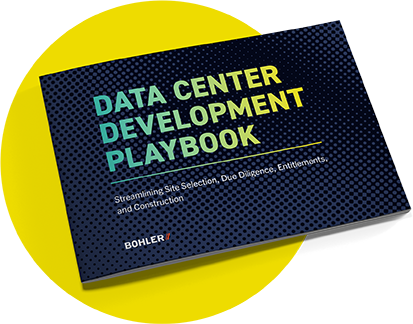Stay in the Know
Get our insights and latest news straight to your inbox.
In the era of growing data centers, fostering community collaboration is essential. Through proactive communication, like Town Hall-style meetings, you can build relationships within the community and better address their apprehensions and concerns around data centers.
With the incorporation of mitigation strategies and sustainable design, data centers can seamlessly coexist within communities while minimizing their local impact. Here are a few strategies used by design and development teams to alleviate neighborhood concerns:
Sound pollution is a significant concern associated with data centers. However, design and development teams can employ a range of strategies, including artificial barriers like trees, shrubs, buildings or soundproof walls to reduce sound and assure minimal disruption to nearby residents.
Another way to reduce sound and land disturbances is strategic site layout planning. This technique uses the land’s shape and equipment location to block sound waves and minimize exposure to neighboring properties.

Basic “gray box” warehouse structures are often another pain point for communities. However, design teams can transform these buildings into structures that soften the data center’s look with faux windows, appealing color schemes and even dynamic light displays – effectively blending them into their surroundings and creating a more pleasing visual impact.
Addressing environmental concerns is crucial for data centers to demonstrate their commitment to sustainability. To decrease the facility’s environmental impact, many data center developers and contractors actively seek recycled materials and commit to utilizing green energy sources like wind or solar to power their facilities.
Additionally, stormwater management systems, such as bioswales and rain gardens, help runoff management and treatment, reducing the strain on local water systems and improving water quality. Techniques like reusing gray water and stormwater for cooling minimizes freshwater consumption and can help conserve valuable resources.
Incorporating sustainable stormwater management design facilities not only regulates runoff at data center sites but also improves water quality in the surrounding areas. Data centers may successfully manage rainwater and reduce the impact on nearby water bodies by implementing measures like permeable pavements and bio-retention basins. These measures reduce pollutants and sedimentation, contributing to flood control and the overall health of ecosystems.
Design and development teams play a critical role in building harmonious sustainable data centers that respect both the community and the environment. By implementing these approaches through careful planning and design, data centers can seamlessly integrate with communities, respond and address community concerns, build positive relationships and promote sustainable modern infrastructure.
See Related: Data Centers – Succeeding with Imperfect Sites
Get our insights and latest news straight to your inbox.